
Monday, March 31, 2008
Sunday, March 23, 2008
Easter & Kids Day
1700. That's the number of visitors who came through the museum today. On Easter no less! I'm assuming that we were one of the few places open today. Because of the holiday, none of the Italians were working and I was recruited to be Kid's Day Capo thanks to my art ed background and stellar Italian (to be read with not a small amount of sarcasm). The concept for the art project was not my own but I was responsible for explaining it and for taking the kids on a tour through the museum in a way that related to the project. Most of the fifteen children were Italian but there were a few English speakers as well. This meant I had to explain everything once in Italian and then again in English! It went surprisingly well!
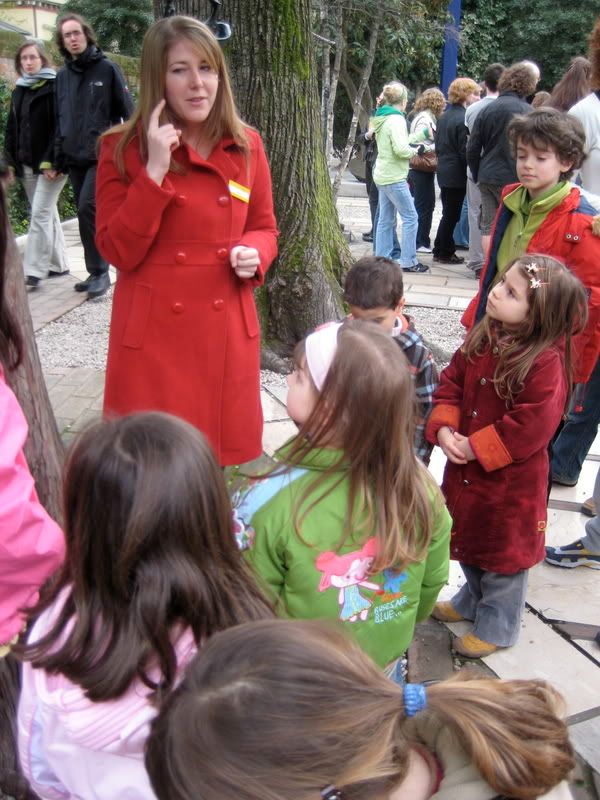
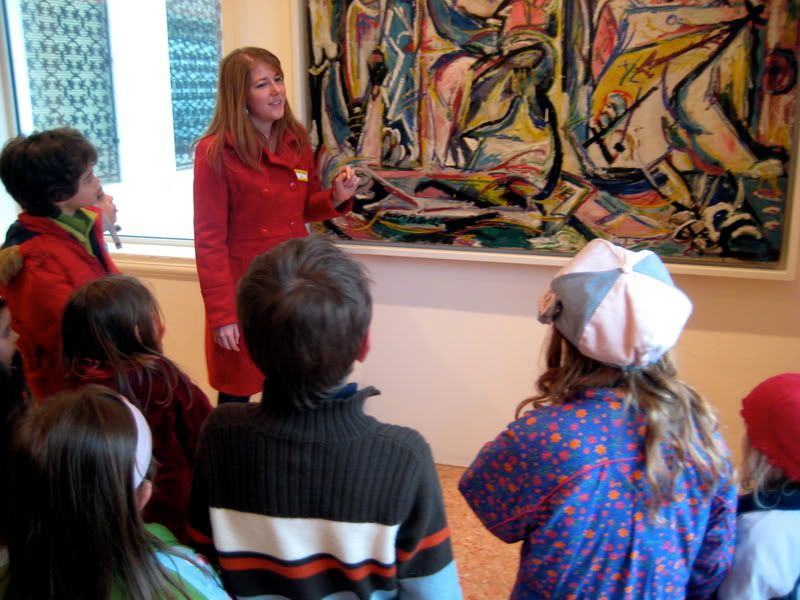
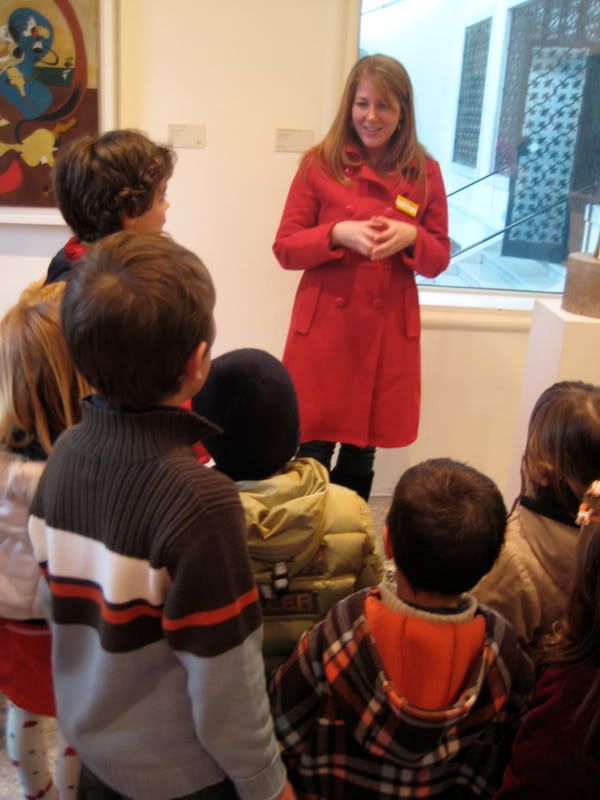
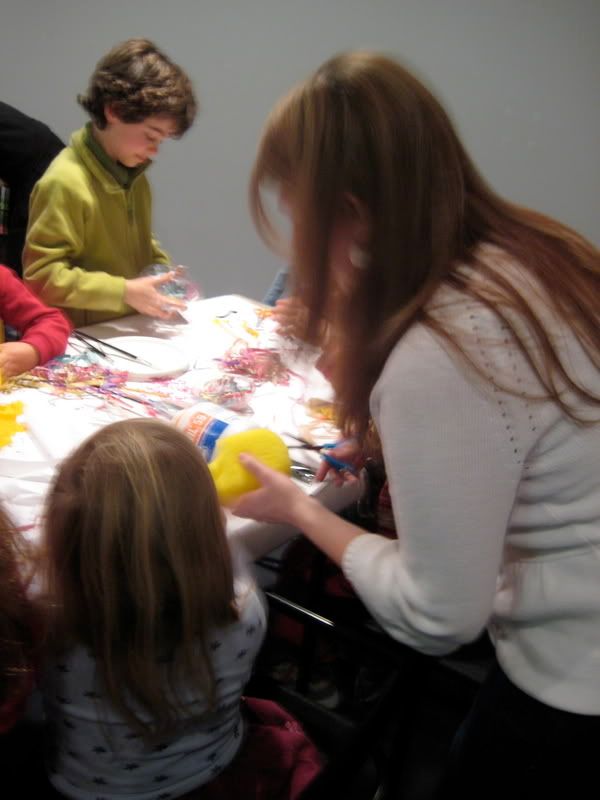






Friday, March 21, 2008
Working Late
Since I've been in Venice, a number of works in the museum have been in the town of Vercelli for an exposition called Peggy Guggenheim and Surrealist Imagery. This week the works returned home and a few of us interns got involved in the re-installation of a number of paintings. Dr. Rylands was, of course, there to oversee everything and he gave me permission to photograph the process!

Dr. Rylands oversees the hanging of an Arp
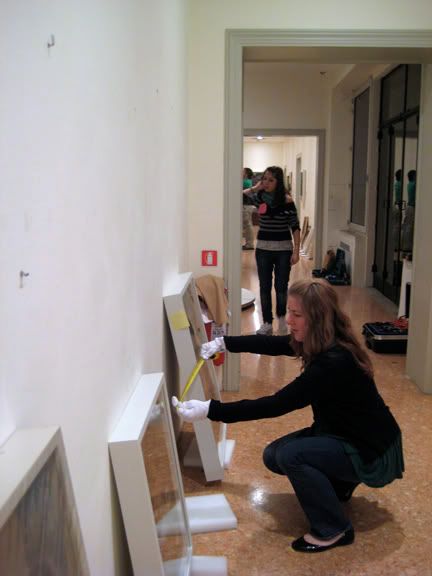
Measuring the space between two paintings

Adjusting Ernst's The Kiss

Dr. Rylands and Eric hang a painting

Leenie takes a break from label mounting
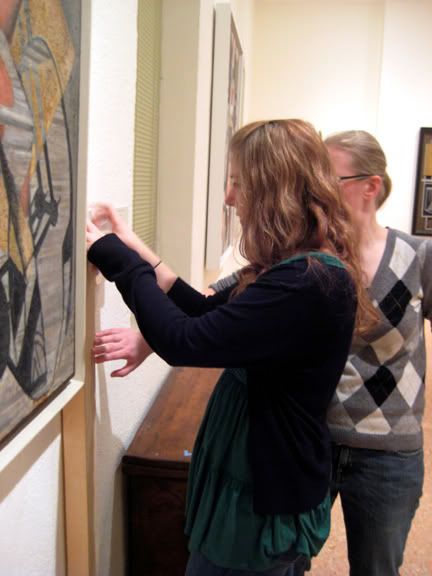
Hanging a label

Dr. Rylands shows Jesse how to adjust the Mondrian

Sandra installing the Arp
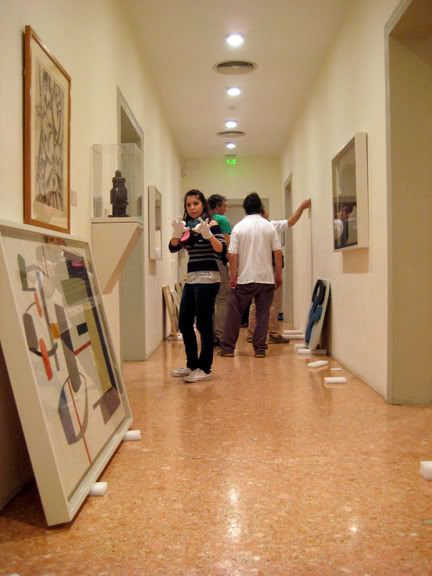
Cinzia in the midst of the ordered chaos

Dr. Rylands oversees the hanging of an Arp

Measuring the space between two paintings

Adjusting Ernst's The Kiss

Dr. Rylands and Eric hang a painting

Leenie takes a break from label mounting

Hanging a label

Dr. Rylands shows Jesse how to adjust the Mondrian

Sandra installing the Arp

Cinzia in the midst of the ordered chaos
Wednesday, March 12, 2008
Friday, February 29, 2008
I'm famous!
Ok, not really, but I am featured in the newest issue of Pratt's newspaper! To check it out, click here
(Gateway>Latest Issues>February 29, 2008 Issue)

(Gateway>Latest Issues>February 29, 2008 Issue)

Thursday, February 28, 2008
Peggy Guggenheim
We have to give both ten and thirty minute talks on the life of Peggy Guggenheim. The following is what I usually say for my ten minute talk. It's long, but worth reading-- I think her life was incredibly fascinating!
Peggy Guggenheim was born into the upper east side of New York City on August 26, 1898. Her father, Benjamin was of the wealthy Guggenheim family who made their money in metal, and her mother Florette was of the wealthy banking Seligmann family. Peggy’s childhood was privileged. She attended excellent schools, was exposed to art and theater and traveled to Europe with her family.

Florrette and Benjamin Guggenheim

Peggy, as painted by Franz von Lenbach

Peggy (at left) and her sisters Hazel and Benita

Peggy as a Geisha Girl, 1908
Things changed in 1912, when Benjamin, after installing the new steam pump elevators in the Eiffel Tower was returning home to his family on the first voyage of the Titanic. Though as an 1st class passenger, he was guaranteed a place on a life raft, Benjamin, dressed to the nines, perished. Along, with Benjamin’s death, Peggy’s family experienced diminished wealth as they had to pay off her father’s creditors. However, Peggy still inherited some $400,000, a hefty sum at that time.
In 1919, upon graduating from college, Peggy traveled throughout the United States with a friend, vowing to see as much of the country as possible. Eventually, she ended up in Cincinnati where she entrusted a doctor to perform plastic surgery on her nose, which she’d often compared to that of her sisters’. The surgeon, however, decided mid-way through the surgery, that it was too difficult a procedure and did not finish what he’d begun. Peggy spent the next two months hiding from her friends and the public, as she was left with a much larger nose than before.

Peggy in a 1924 portrait by Man Ray
After regaining some of her confidence, Peggy moved to Paris. There, she became reacquainted with Laurence Vail, an artist and poet whom she’d briefly met in New York. The two began a love affair and shortly thereafter, after they’d ridden up the elevators her father had installed, Laurence proposed. The two were married about two months later.

Laurence Vail
Their marriage was a tumultuous one. By some claims, Laurence was abusive, by others, it was Peggy. The two separated and divorced, but not before they had two children, Sinbad and Pegeen. Peggy would later refer to Laurence as her “eternal husband.”

Peggy, Laurence and Sinbad

Sinbad, Peggy & Pegeen
Peggy then began her first of many love affairs. This would be a common theme in her life and something for which she is often criticized for still today. Tragedy struck again in her life, when this first lover, writer John Holmes, died on an operating table, while having surgery on his wrist. Peggy was left heartbroken and without motivation. Her friend, the same one with whom she’d traveled across the US, suggested that she develop an interest, either becoming a literary publisher or an art dealer. As you can surmise, she chose to pursue the latter.
In 1938, the Guggenheim Jeune opened in London. While organizing a sculpture exhibit, work by Brancusi, Calder, Laurens and others were stopped at customs. James B. Manson, the then director of the Tate Gallery, as an expert for customs authorities, classified the work not as art but as "manufactured goods." Peggy took the matter to the House of Commons which ruled that Manson had gone too far in his judgment of the artwork. Not long after, he lost his position at the Tate, leaving Peggy to remark that her fight had, "rendered a great service to foreign artists and to England."

Work by two of the controversial artists. Brancusi's Maiastra and Head of a Young Girl by Laurens
Guggenheim Jeune, though a success in terms of publicity, was not profitable. Peggy dreamed of opening a museum and contacted her friend, art historian and critic, Herbert Read. Because Peggy herself, was not a good judge of art, Mr. Read made her a list of works that she should seek to buy. Peggy pursued every name on the list and in all collected 10 Picassos, 40 Ernsts, 8 Miros, 4 Magrittes, 3 Man Rays, 3 Dalis, 1 Klee and 1 Chagall. And many many more works.

Herbert Read and Peggy
However, at the same time that Peggy was collecting for her new museum, the Nazis were marching on Europe. It soon became evident that plans for a museum would need to be put on hold and Peggy would need to return to America. But what would she do with the artwork? She contacted the Louvre, which said that the collection was not important nor old enough to be given room in their storage rooms. Ultimately, the solution was to pack the artwork in boxes marked “Household Goods.” In this way, Peggy’s collection was shipped safely out of Europe.
Peggy did not only bring valuable artwork into the states, but she also provided safe passage to a number of friends and family. Her ex-husband Laurence Vail, his soon to be ex-wife Kay and their children, Sinbad and Pegeen, the artist Max Ernst and a few others were all brought safely to the United States thanks to Peggy’s wealth. Peggy has said that the voyage included, “one husband, two ex-wives, seven children and one future husband.”
Max Ernst was that future husband. Shortly after arriving in New York, he was reluctantly convinced to become Peggy’s bridegroom. Peggy paid room and board and Max contributed by providing Peggy with paintings. In this way, her collection has a number of Max Ernst originals.

The Robing of the Bride, Max Ernst, 1940
In 1942, Peggy opened Art of This Century. This gallery pushed the limits of the traditional exhibition space. It was widely acclaimed, placing Peggy at the forefront of the New York City art scene.

The Art of This Century
During this time, she was introduced to the work of Jackson Pollock. Though she was not impressed, her advisers recommended that she give the unknown artist his own show. Peggy provided Jackson Pollack with a generous stipend which was truly necessary. He was, at the time, employed as a carpenter at the Solomon R. Guggenheim museum, and once he exhibited at Art of This Century, he would no doubt lose his position there. Thanks to Peggy’s stipend, Mr. Pollock was able to move from his cramped apartment to a large barn outside of the city, allowing him to work on much bigger canvases which he could then lay down, instead of working vertically.

Jackson Pollock at work
Europe still called to Peggy and in 1947, she divorced Max Ernst and returned to Europe. In 1948, because Greece was embattled in it’s civil war, its pavilion at the Venice Biennale was free. Peggy was invited to exhibit her collection there. She later said of the event, “What I enjoyed most was seeing the name Guggenheim appearing on the maps in the Public Gardens next to the names of Great Britain, France, Holland…I felt as though I were a new European country.”

Peggy was making a name for herself in Venice. She was known as “L’Americana con I cani,” or “The American with the dogs” thanks to her numerous precious dogs who accompanied her everywhere. In fact, fifteen of them are buried next to her today, listed by name with the birth and death dates and a plaque reading, “My Beloved Babies.”

Peggy and her babies
As Peggy introduced herself into Venetian life, she decided that she wanted to permanently settle here. In 1949, she bought Palazzo Venier dei Leoni, dei Leoni meaning “of the lions,” likely because of the yawning lions on the palazzo’s façade but also rumored to be because a former owner had kept lions in the garden. The palazzo is also nicknamed “Palazzo non finito” because though it was originally intended to be five stories high, it was only built to be one story high. History has not recorded the reason for this.

Palazzo Venier dei Leoni as seen from the Grand Canal
Peggy spent the remainder of her years in Venice, exhibiting her collection in her home. While visitors strolled through her garden and her exhibition, she’d hide out in her bedroom which overlooked the Grand Canal. She had many visitors over the years, including Yoko Ono and John Lennon, Truman capote, George Balanchine and nearly all of the artists in her collection and many others who wished to be represented there.
Many institutions and museums, began courting Peggy for her collection. There was a moment of vindication when the Tate requested a show of her work despite it's former director having dismissed it years earlier.
Peggy remained quite the character all of her life, keeping numerous lovers, having affairs with many of the artists she came to know and owning the last private gondola in Venice.

Peggy on her throne in the sculpture garden
In 1979, Peggy died and was interred on her property. Her collection was left to the Solomon R. Guggenheim Museum, with the request that it be left in tact, in Venice. It is still on display much of the way it was in Peggy’s lifetime.

Peggy and her "beloved babies" interned in the sculpture garden
Peggy Guggenheim was born into the upper east side of New York City on August 26, 1898. Her father, Benjamin was of the wealthy Guggenheim family who made their money in metal, and her mother Florette was of the wealthy banking Seligmann family. Peggy’s childhood was privileged. She attended excellent schools, was exposed to art and theater and traveled to Europe with her family.

Florrette and Benjamin Guggenheim

Peggy, as painted by Franz von Lenbach

Peggy (at left) and her sisters Hazel and Benita

Peggy as a Geisha Girl, 1908
Things changed in 1912, when Benjamin, after installing the new steam pump elevators in the Eiffel Tower was returning home to his family on the first voyage of the Titanic. Though as an 1st class passenger, he was guaranteed a place on a life raft, Benjamin, dressed to the nines, perished. Along, with Benjamin’s death, Peggy’s family experienced diminished wealth as they had to pay off her father’s creditors. However, Peggy still inherited some $400,000, a hefty sum at that time.
In 1919, upon graduating from college, Peggy traveled throughout the United States with a friend, vowing to see as much of the country as possible. Eventually, she ended up in Cincinnati where she entrusted a doctor to perform plastic surgery on her nose, which she’d often compared to that of her sisters’. The surgeon, however, decided mid-way through the surgery, that it was too difficult a procedure and did not finish what he’d begun. Peggy spent the next two months hiding from her friends and the public, as she was left with a much larger nose than before.

Peggy in a 1924 portrait by Man Ray
After regaining some of her confidence, Peggy moved to Paris. There, she became reacquainted with Laurence Vail, an artist and poet whom she’d briefly met in New York. The two began a love affair and shortly thereafter, after they’d ridden up the elevators her father had installed, Laurence proposed. The two were married about two months later.

Laurence Vail
Their marriage was a tumultuous one. By some claims, Laurence was abusive, by others, it was Peggy. The two separated and divorced, but not before they had two children, Sinbad and Pegeen. Peggy would later refer to Laurence as her “eternal husband.”

Peggy, Laurence and Sinbad

Sinbad, Peggy & Pegeen
Peggy then began her first of many love affairs. This would be a common theme in her life and something for which she is often criticized for still today. Tragedy struck again in her life, when this first lover, writer John Holmes, died on an operating table, while having surgery on his wrist. Peggy was left heartbroken and without motivation. Her friend, the same one with whom she’d traveled across the US, suggested that she develop an interest, either becoming a literary publisher or an art dealer. As you can surmise, she chose to pursue the latter.
In 1938, the Guggenheim Jeune opened in London. While organizing a sculpture exhibit, work by Brancusi, Calder, Laurens and others were stopped at customs. James B. Manson, the then director of the Tate Gallery, as an expert for customs authorities, classified the work not as art but as "manufactured goods." Peggy took the matter to the House of Commons which ruled that Manson had gone too far in his judgment of the artwork. Not long after, he lost his position at the Tate, leaving Peggy to remark that her fight had, "rendered a great service to foreign artists and to England."

Work by two of the controversial artists. Brancusi's Maiastra and Head of a Young Girl by Laurens
Guggenheim Jeune, though a success in terms of publicity, was not profitable. Peggy dreamed of opening a museum and contacted her friend, art historian and critic, Herbert Read. Because Peggy herself, was not a good judge of art, Mr. Read made her a list of works that she should seek to buy. Peggy pursued every name on the list and in all collected 10 Picassos, 40 Ernsts, 8 Miros, 4 Magrittes, 3 Man Rays, 3 Dalis, 1 Klee and 1 Chagall. And many many more works.

Herbert Read and Peggy
However, at the same time that Peggy was collecting for her new museum, the Nazis were marching on Europe. It soon became evident that plans for a museum would need to be put on hold and Peggy would need to return to America. But what would she do with the artwork? She contacted the Louvre, which said that the collection was not important nor old enough to be given room in their storage rooms. Ultimately, the solution was to pack the artwork in boxes marked “Household Goods.” In this way, Peggy’s collection was shipped safely out of Europe.
Peggy did not only bring valuable artwork into the states, but she also provided safe passage to a number of friends and family. Her ex-husband Laurence Vail, his soon to be ex-wife Kay and their children, Sinbad and Pegeen, the artist Max Ernst and a few others were all brought safely to the United States thanks to Peggy’s wealth. Peggy has said that the voyage included, “one husband, two ex-wives, seven children and one future husband.”
Max Ernst was that future husband. Shortly after arriving in New York, he was reluctantly convinced to become Peggy’s bridegroom. Peggy paid room and board and Max contributed by providing Peggy with paintings. In this way, her collection has a number of Max Ernst originals.

The Robing of the Bride, Max Ernst, 1940
In 1942, Peggy opened Art of This Century. This gallery pushed the limits of the traditional exhibition space. It was widely acclaimed, placing Peggy at the forefront of the New York City art scene.

The Art of This Century
During this time, she was introduced to the work of Jackson Pollock. Though she was not impressed, her advisers recommended that she give the unknown artist his own show. Peggy provided Jackson Pollack with a generous stipend which was truly necessary. He was, at the time, employed as a carpenter at the Solomon R. Guggenheim museum, and once he exhibited at Art of This Century, he would no doubt lose his position there. Thanks to Peggy’s stipend, Mr. Pollock was able to move from his cramped apartment to a large barn outside of the city, allowing him to work on much bigger canvases which he could then lay down, instead of working vertically.

Jackson Pollock at work
Europe still called to Peggy and in 1947, she divorced Max Ernst and returned to Europe. In 1948, because Greece was embattled in it’s civil war, its pavilion at the Venice Biennale was free. Peggy was invited to exhibit her collection there. She later said of the event, “What I enjoyed most was seeing the name Guggenheim appearing on the maps in the Public Gardens next to the names of Great Britain, France, Holland…I felt as though I were a new European country.”

Peggy was making a name for herself in Venice. She was known as “L’Americana con I cani,” or “The American with the dogs” thanks to her numerous precious dogs who accompanied her everywhere. In fact, fifteen of them are buried next to her today, listed by name with the birth and death dates and a plaque reading, “My Beloved Babies.”

Peggy and her babies
As Peggy introduced herself into Venetian life, she decided that she wanted to permanently settle here. In 1949, she bought Palazzo Venier dei Leoni, dei Leoni meaning “of the lions,” likely because of the yawning lions on the palazzo’s façade but also rumored to be because a former owner had kept lions in the garden. The palazzo is also nicknamed “Palazzo non finito” because though it was originally intended to be five stories high, it was only built to be one story high. History has not recorded the reason for this.

Palazzo Venier dei Leoni as seen from the Grand Canal
Peggy spent the remainder of her years in Venice, exhibiting her collection in her home. While visitors strolled through her garden and her exhibition, she’d hide out in her bedroom which overlooked the Grand Canal. She had many visitors over the years, including Yoko Ono and John Lennon, Truman capote, George Balanchine and nearly all of the artists in her collection and many others who wished to be represented there.
Many institutions and museums, began courting Peggy for her collection. There was a moment of vindication when the Tate requested a show of her work despite it's former director having dismissed it years earlier.
Peggy remained quite the character all of her life, keeping numerous lovers, having affairs with many of the artists she came to know and owning the last private gondola in Venice.

Peggy on her throne in the sculpture garden
In 1979, Peggy died and was interred on her property. Her collection was left to the Solomon R. Guggenheim Museum, with the request that it be left in tact, in Venice. It is still on display much of the way it was in Peggy’s lifetime.

Peggy and her "beloved babies" interned in the sculpture garden
Tuesday, February 26, 2008
Foggy Venice
It has been extremely foggy these past few days in Venice. It's especially eerie when walking home along the Zattere, where the water recedes into nothing and you can hear but not see boats as they pass! These photos were taken during closing time at the museum, on the back terrace facing the Grand Canal










Monday, February 25, 2008
San Michele
In the 1800s, Napoleon's occupying forces decreed that Venetians be required to bury their dead on an island instead of mainland Venice. The result was San Michele, il cemetario. Today, Catholic Venetians are only allowed to remain in the ground for a few years until they are then removed to an ossuary.




Protestants and Foreigners are allowed their plots for much longer. Though, they're not so well cared for.


Also, they have super cool statues on the island:





Protestants and Foreigners are allowed their plots for much longer. Though, they're not so well cared for.


Also, they have super cool statues on the island:

Thursday, February 21, 2008
Days Off

This Tuesday, the interns, on our day off, were treated to a tour of the Gallerie dell'Accademia's exhibition L'Ultimo Tiziano. I've always been a Tiziano (Titian) fan, but even more exciting was that the director of the Peggy Guggenheim Collection, Philip Rylands, was our tour guide. His early studies were on Tiziano, though he also took us through the main galleries to discuss work by Bellini, Tintoretto and Veronese. Yesterday evening, we were again priveleged to have have Dr. Rylands give us his time. All the interns met in the Guggenheim library, where he answered any questions we had about directing the museum, collecting art, Venice and the history of the Guggenheim.
On Tuesday, after the tour at the Accademia, a large group of us went to a trattoria and had a worker's lunch. This is a multi-course meal usually meant for the blue collar workers of the city. Somehow one of our fellow interns finagled them into giving us the same deal. Three courses including wine for 10 euros!



After lunch, a few of us got gelato from Gelateria Nico, a Venetian favorite and sat on the Zattere enjoying the view.

We then headed over to Palazzo Grassi to see the Roma e i Barbari (Rome and the Barbarians) exhibit, as the Guggenheim will reimburse us for any museums we visited that day. The show was impressive because it contained numerous artifacts from the barbarians--it was almost overwhelming how many there were. The fact that they were as well preserved as they were was astonishing.

Much of yesterday, also a day off, was spent riding vaporetti. My roommate Christina and I went to Cemeterio, Murano and Burano. Photos of that coming soon!
Subscribe to:
Comments (Atom)

